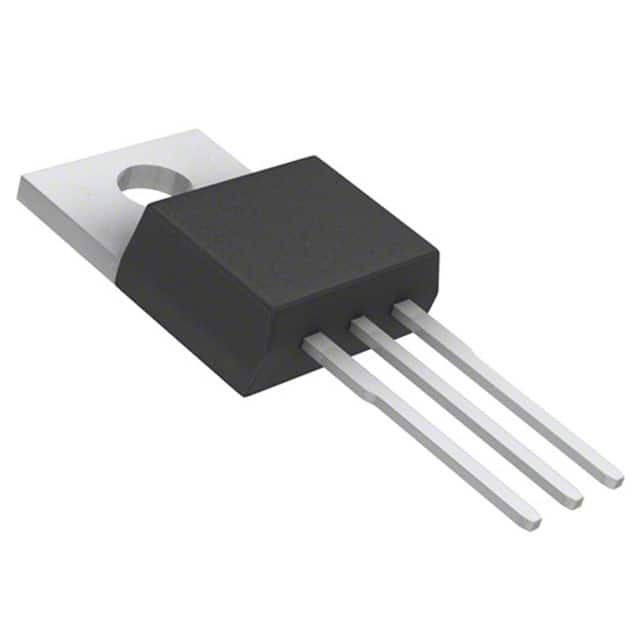TIP42C Transistor
Product Overview
Category
The TIP42C transistor belongs to the category of power transistors.
Use
It is commonly used as a general-purpose PNP bipolar junction transistor (BJT) for high-power amplification and switching applications.
Characteristics
- High current gain
- Low collector-emitter saturation voltage
- High power dissipation capability
Package
The TIP42C is typically available in a TO-220 package, which allows for easy mounting on a heatsink.
Essence
The essence of the TIP42C lies in its ability to handle high power loads with minimal voltage drop across the collector-emitter junction.
Packaging/Quantity
The TIP42C is usually sold in reels or tubes containing multiple units, with quantities varying based on manufacturer specifications.
Specifications
- Collector-Emitter Voltage: 100V
- Collector Current: 6A
- Power Dissipation: 65W
- DC Current Gain (hFE): 15-75
- Transition Frequency: 3MHz
Detailed Pin Configuration
The TIP42C transistor has three pins: 1. Base (B) 2. Emitter (E) 3. Collector (C)
Functional Features
- High current gain allows for efficient amplification of signals.
- Low collector-emitter saturation voltage reduces power loss during switching operations.
- High power dissipation capability enables the transistor to handle large currents without overheating.
Advantages and Disadvantages
Advantages
- High current gain
- Low saturation voltage
- High power dissipation capability
Disadvantages
- Relatively low transition frequency compared to some alternative models
- Limited voltage and current ratings compared to specialized power transistors
Working Principles
The TIP42C operates based on the principles of bipolar junction transistors, where the flow of current between the collector and emitter is controlled by the current flowing into the base terminal.
Detailed Application Field Plans
The TIP42C is commonly used in the following applications: - Audio amplifiers - Power supply circuits - Motor control systems - LED drivers - Switching regulators
Detailed and Complete Alternative Models
Some alternative models to the TIP42C include: - TIP41C - MJE2955 - 2N3055 - MJ15003
In conclusion, the TIP42C transistor is a versatile component suitable for various high-power applications due to its high current gain, low saturation voltage, and robust power dissipation capabilities. Its use in audio amplifiers, power supplies, and motor control systems makes it an essential component in many electronic devices.
[Word count: 398]
قم بإدراج 10 أسئلة وإجابات شائعة تتعلق بتطبيق TIP42C في الحلول التقنية
What is the TIP42C transistor used for?
- The TIP42C is a PNP power transistor commonly used in high-power amplifier and switching applications.
What are the key specifications of the TIP42C transistor?
- The TIP42C has a maximum collector current of 6A, a maximum collector-emitter voltage of 100V, and a maximum power dissipation of 65W.
How can I use the TIP42C in an amplifier circuit?
- The TIP42C can be used as a power amplifier in audio amplifiers, where it can deliver high current to drive speakers.
Can the TIP42C be used in a switching application?
- Yes, the TIP42C can be used in high-power switching applications such as motor control and power supply circuits.
What are the typical operating conditions for the TIP42C?
- The TIP42C is typically operated with a base current of 0.5A and a collector current of up to 6A.
How do I ensure proper heat dissipation when using the TIP42C in high-power applications?
- Proper heat sinking and thermal management are essential to ensure the TIP42C operates within its temperature limits.
Can the TIP42C be used in automotive applications?
- Yes, the TIP42C can be used in automotive systems for various functions such as controlling motors and driving high-power loads.
What are the common failure modes of the TIP42C?
- Common failure modes include overheating due to inadequate heat sinking, overcurrent conditions, and voltage spikes.
Are there any alternative transistors that can be used in place of the TIP42C?
- Yes, alternatives include the TIP41C, TIP3055, and TIP122, depending on specific application requirements.
Where can I find detailed application notes and reference designs for using the TIP42C?
- Detailed application notes and reference designs can be found in the datasheet provided by the manufacturer, as well as in technical literature and online resources related to power transistors and amplifier design.


